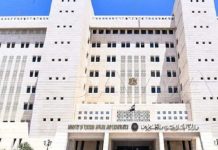Al-Thawra Net
Human Rights Watch (HR) has criticized the US for selling cluster munitions to Saudi Arabia, urging Riyadh to stop using such banned arms that leave behind unexploded sub-munitions and endanger civilians.
On Friday, Steve Goose, arms director at HRW and chair of the Cluster Munitions Coalition, an international coalition of groups working to eradicate cluster munitions, called on Washington to stop producing and selling the internationally-banned weapons in compliance with international law.
“The US has sold Saudi Arabia cluster munitions, a weapon most countries have rejected due to the harm they cause civilians,” said Goose, adding “Saudi Arabia should stop using cluster munitions in Yemen or anywhere else, and the US should stop producing and exporting them.”
Goose went on to say that Saudi Arabia has used various types of US-made cluster munitions, including CBU-105 Sensor Fuzed Weapons, in its war against Yemen despite evidence of mounting civilian casualties.
“Following multiple attacks in Yemen, it is now obvious that Sensor Fuzed Weapons are not the ‘reliable’ or ‘intelligent’ cluster munitions they have been promoted as,” said Goose, noting, “The US should cease production and transfer of these weapons following the evidence of their failures and their use in and near civilian areas and should join the international ban on cluster munitions.”
Experts say CBU-105 is designed to explode above the ground and project an explosively formed jet of metal and fragmentation downward. The cluster ammunition is equipped with electronic self-destruct and self-deactivation features.
Saudi Arabia and the United Arab Emirates (UAE) have both received CBU-105 Sensor Fuzed Weapons from the US in recent years. The US also provided Saudi Arabia with significant exports of other cluster bombs between 1970 and 1999.
The New York-based leading international rights groups also say the US has endangered many civilian lives by selling the cluster bombs to Riyadh regime.
This comes as internationally-banned cluster munitions supplied by the United States have numerously been used in the relentless war.
In the past year, HRW documented civilian casualties in Yemen from the use of four types of US-made air-dropped and ground-launched cluster munitions against Yemenis. This includes using CBU-105 Sensor Fuzed Weapons in at least six airstrikes in the Yemeni provinces of Amran, Hodaida, Sa’ada and Sana’a.
In Mid February, a CBU-105 attack was recorded on camera, at a cement factory in Amran Province, 40 kilometers northwest of the capital, Sana’a.
Mujahid Nasser Shalef, a journalist from Yemen’s al-Masirah TV provided HRW with a 37-second video filmed during the attack.
Recalling horrific impacts of the Saudi strikes, the journalist said, “At about 5 p.m. we were standing on the roof of a neighboring house … when suddenly we saw a bomb blast, but this was a different kind. It exploded in the air and released tons of smaller bombs into the air. Some of them exploded in the air, others exploded when they hit the mountain. When they exploded they released black smoke.”
Fawaz Saleh al-Qishwi, 36, an electrical engineer from the neighboring al-Darb village, less than a kilometer from the cement factory, also witnessed the attack and said, “I saw a plane coming from the east. It dropped the cluster bombs. I heard a number of explosions from the bombs. None of the [bomblets] came to the village. Later, I went with my friend to the mountain and took a piece.”
Qishwi showed HRW researchers the remnants that he collected, which were identified as a suspension lug and piece of a parachute from a BLU-108 canister used in the CBU-105.
Jamal Yehia al-Hadek, the cement factory’s security chief, said, “I saw an explosion in the air, then pieces came out and spread into the sky with parachutes, like a net.”
Saudi regime has also recently used US-made cluster bombs in two recent airstrikes on a busy market in Yemen.
On April 7, HRW said its investigators traveled to the town in Yemen’s Hajjah province the day after the attack and listed the names of 97 civilians killed in the strike, including 25 children. The team said that another 10 bodies were burned beyond recognition, bringing the total number of victims to 107.
They found fragments of a GBU-31 satellite-guided bomb as well as its guidance equipment supplied by the US, matching an earlier report by British television channel ITV.
The US has backed the Saudi campaign in Yemen. In November last year, Washington approved a $1.29 billion rearming program for Riyadh, including thousands of similar bombs.
Saudi Arabia began its military aggression against Yemen on March 26, 2015.
Nearly 9,400 people, among them over 2,230 children, have been killed and over 16,000 others injured since the onset of the military raids. According to the UN, airstrikes account for 60 percent of the civilians killed so far; Press TV reported.
























